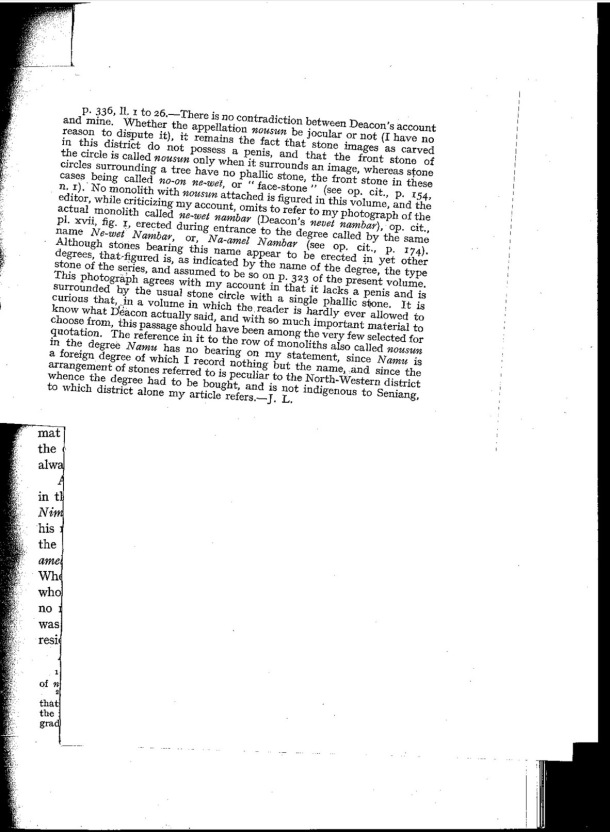|
|  [Note: this transcription was produced by an automatic OCR engine]
p. 336, ll. 1 to 26.—There is no contradiction between Deacon's account
and mine. Whether the appellation nausun be jocula: or not (I have no
reason to dispute it), it remains the fact that stone images as carved
in this district do not possess a penis, and that the front stone of
the circle is called nousun only when it surrounds an image, whereas stone
circles surrounding a tree ha
ve no phallic stone, the front stone in these
cases being called m7~0n ne-wet, or "face-stone " . '
n. r). V ' '
(see op cit., p. r54,
J. o monolith with nrmsim attached is ï¬Ågured in this volume, and the
editor, while criticizing my account, omits to refer to my photograph of the
actual monolith called ne~w.et nambay [Deacon’s new! nambar), op. cit.,
pl. xvii, ï¬Åg. 1, erected during entrance to the degree called by the same
name Ne-u/at Nambai, or, Na-ame! Number (see op. cit., p. 174).
Although stones bearing this name appear to he erected in yet other
degrees, thatï¬Ågured is, as indicated by the name of the degree, the type
stone of the series, and assumed to be so on p. 323 of the present volume.
This photograph agrees with my account in that it lacks a penis and is
surrounded by the usual stone circle with a single phallic stone. It is
curious that, ‘in a volume in which the reader is hardly ever allowed to
know what Deacon actually said, and with so much important material to
choose from, this passage should have been among the very few selected for
quotation, The reference iii it to the row of inonoliths also called nousun
in the degree Namu has no bearing on my statement, since Nrmm is
a foreign degree of which I record nothing but the name, and since the
arrangement of stones referred to is peculiar to the North~Westerii district
whence the degree had to be b h ' ' ' '
“I
oug t, and is not indigenous to Seniang,
to hich district alone my article refers.—]. L.
mat
the i
alwa,
}
in tl
Nim
his 1
the
ame.
VVh1
who
no l
was
resi~
1
of n
r
that
the
Bred‘
|